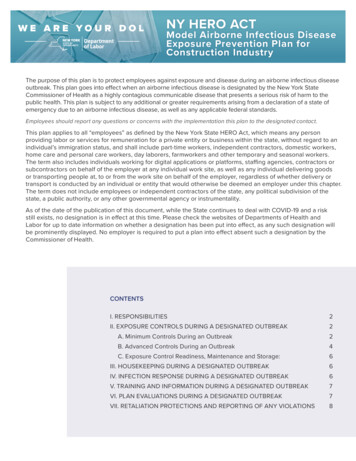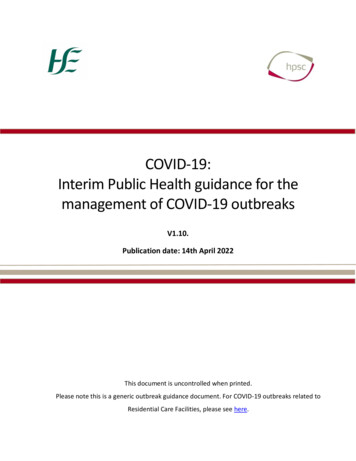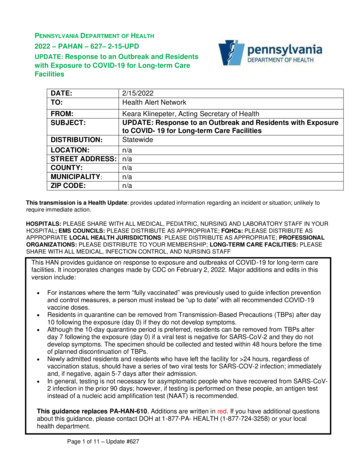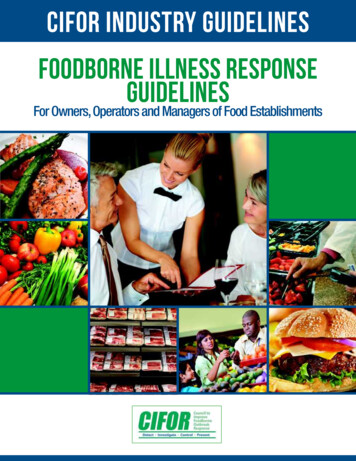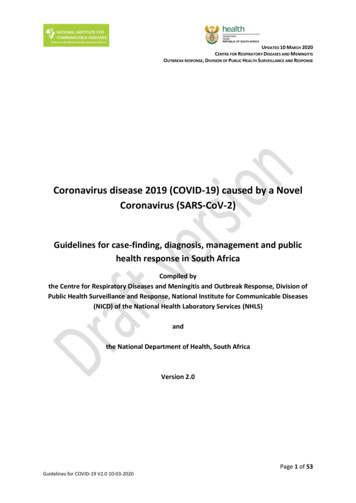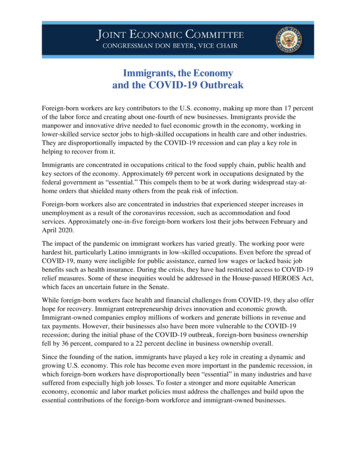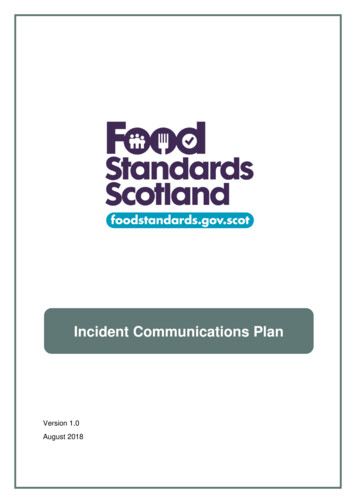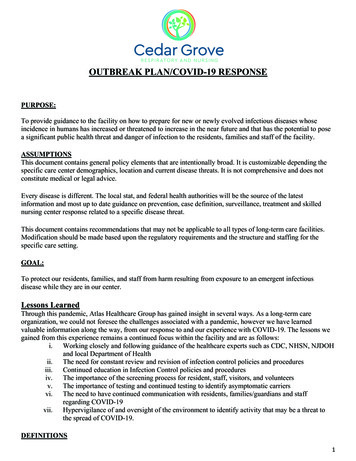
Transcription
OUTBREAK PLAN/COVID-19 RESPONSEPURPOSE:To provide guidance to the facility on how to prepare for new or newly evolved infectious diseases whoseincidence in humans has increased or threatened to increase in the near future and that has the potential to posea significant public health threat and danger of infection to the residents, families and staff of the facility.ASSUMPTIONSThis document contains general policy elements that are intentionally broad. It is customizable depending thespecific care center demographics, location and current disease threats. It is not comprehensive and does notconstitute medical or legal advice.Every disease is different. The local stat, and federal health authorities will be the source of the latestinformation and most up to date guidance on prevention, case definition, surveillance, treatment and skillednursing center response related to a specific disease threat.This document contains recommendations that may not be applicable to all types of long-term care facilities.Modification should be made based upon the regulatory requirements and the structure and staffing for thespecific care setting.GOAL:To protect our residents, families, and staff from harm resulting from exposure to an emergent infectiousdisease while they are in our center.Lessons LearnedThrough this pandemic, Atlas Healthcare Group has gained insight in several ways. As a long-term careorganization, we could not foresee the challenges associated with a pandemic, however we have learnedvaluable information along the way, from our response to and our experience with COVID-19. The lessons wegained from this experience remains a continued focus within the facility and are as follows:i.Working closely and following guidance of the healthcare experts such as CDC, NHSN, NJDOHand local Department of Healthii.The need for constant review and revision of infection control policies and proceduresiii.Continued education in Infection Control policies and proceduresiv.The importance of the screening process for resident, staff, visitors, and volunteersv. The importance of testing and continued testing to identify asymptomatic carriersvi.The need to have continued communication with residents, families/guardians and staffregarding COVID-19vii.Hypervigilance of and oversight of the environment to identify activity that may be a threat tothe spread of COVID-19.DEFINITIONS1
Cohorting – means the practice of grouping patients who are or are not colonized or infected with the sameorganism to confine their care to one area and prevent contact with other residents.Emerging Infectious Disease – Infectious diseases who incidence in humans has increased in the past twodecades or threatens to increase in the near future have been defined as “emerging”. These diseases, whichrespect no national boundaries, include:i.ii.iii.iv.New infections resulting from changes or evolution of existing organismsKnown infections spreading to new geographic areas or populationsPreviously unrecognized infections appearing in areas undergoing ecologic transformationOld infections reemerging as a result of antimicrobial resistance in known agents or breakdowns inpublic health measures.Endemic level – means the usual level of given disease in a geographic areaEpidemic – refers to an increase, often sudden, in the number of cases of a disease above what is normallyexpected in that population in that area.Isolating – means the process of separating sick, contagious persons from those who are sickLong-term care facility – means a nursing home, assisted living residence, comprehensive personal care home,residential health care facility or dementia care home licensed pursuant to P.L. 1971, c.136 (C.26:2H-1 et seq.)Outbreak – According to the Centers of Disease Control and Prevention, an outbreak is an occurrence of morecases of a disease than would be normally expected in a specific place or group of people over a given period.Pandemic – A sudden infectious disease outbreak that becomes very widespread and affects a whole region, acontinent, or the world due to a susceptible population. By definition, a true pandemic causes a high degree ofmortality.General Preparedness for Emergent Infectious Diseases (EID)a. The care center’s emergency operation program will include a response plan for a community-wideinfectious disease outbreak such as pandemic influenza. This plan will:i.build on the workplace practices described in the infection prevention and control policiesii.include administrative controls (screening, isolation, visitors)iii.address environmental controls (isolation rooms, plastic barriers, sanitation stations, and specialareas for contaminated waste)iv.address human resource issues such as employee leavev. be compatible with the care center’s business continuity plan.b. Clinical leadership will be vigilant and stay informed about EIDs around the world. They will keepadministrative leadership briefed as needs on potential risks of new infections in their geographiclocation through the changes to existing organisms and/or immigration, tourism or other circumstances.c. As part of the emergency operations plan, the care center will maintain a supply of personal protective2
equipment (PPE) including moisture-barrier gowns, face masks, assorted sizes of disposable N95respirators and gloves. The amount that is stored will minimally be enough for several days of centerwide-care but will be determined based on storage space and costs.d. The care center will develop plans with their vendors for re-supply of food, medications, sanitizingagents and PPE in the event of a disruption to normal business including EID outbreak.e. The care center will regularly train employees on EID response through drills and exercises as part ofthe center’s emergency preparedness training.f. The care center has contracted with infectious Disease: Michael Barnish, DO. FAC.Local Threata. Once notified by the public health authorities at either federal, state and/or local level that the EID islikely to or already has spread to the care center’s community, the care center will activated specificsurveillance and screening as instructed by Centers for Disease Control and Prevention (CDC), stateagency and/or local public health authorities.b. The care center’s Infection Preventionist (IP) will research the specific signs, symptoms, incubationperiod and route of infection, the risk of exposure, and the recommendations for skilled nursing carecenters as provided by the CDC, Occupational Health and Safety Administration (OSHA), and otherrelevant local, state and federal health agencies.c. Working with advice from the care center’s medical director and/or clinical consultant, Director ofNursing, Administrator , facility laboratory (Aculabs, Genesis), local and state public health authorities,the IP will review and revise internal policies and procedures, ensure medications, environmentalcleaning agents, and personal protective equipment (PPE) is available as indicated by the specificdisease threat.d. Staff will be educated on the exposure risk, symptoms, and prevention of the EID. Place specialemphasis on reviewing the basic infection prevention and control, use of PPE, isolation and otherinfection prevention strategies.e. If the EID is spreading through an airborne route, the care center will activate its plan to ensure thatemployees who may be required to care for a resident with the suspected or known case are not put atundue risk of exposure.f. Provide residents and families with education about the disease and the care the center’s responsestrategy at a level appropriate to their interest and need for information.g. Brief contractors and other relevant stakeholders on the care center’s policies and procedures related tominimizing exposure risks to residents.3
h. Post signs regarding hand sanitation and respiratory etiquette and/or other prevention strategies relevantto the route of infection at the entry of care center along with instruction that anyone who is sick is askedto refrain from visiting the center.i. To ensure that staff, and/or new residents are not at risk of spreading the EID into the care center,screening for exposure risk and signs and symptoms may be done prior to admission of a new residentand/or allowing new staff persons to report to work.j. Self-screening – staff will be educated on the care center’s plan to control exposure to the residentsi.Reporting any suspected exposure to the EID while off duty to their supervisor and public healthii.Precautionary removal of employees who report and actual or suspected exposure to the EID.iii.Self-screening for symptoms prior to reporting to workiv.Prohibiting staff from reporting to work if they are sick until cleared to do so by appropriatemedical authorities and in compliance with appropriate labor lawsk. Self-isolation- in the event there are confirmed cases of the EID in the local community, the care centermay consider closing the care center to new admissions, and limiting visitors based on the advice oflocal public health authorities.l. Environmental cleaning – the care center will follow current CDC guidelines for environmental cleaningspecific to the EID in addition to routine cleaning for the duration of the threat.m. Engineering controls – the care center will utilize appropriate physical plant alterations such as use ofprivate rooms for high-risk residents, plastic barriers, sanitation stations, and special areas forcontaminated wastes as recommended by local, state and federal public health authorities.Suspected Case in the Care Centera. Place a resident or on-duty staff who exhibits symptoms of the EID in an isolation room and notify thelocal public health.b. Under the guidance of public health authorities, arrange a transfer of the suspected infectious person tothe appropriate acute care center via emergency medical services as soon as possible.c. If the suspected infectious person requires care while awaiting transfer, follow care center policies forisolation procedures, including all recommended PPE for staff at risk for exposure.d. Keep the number of staff assigned to enter the room of the isolated person to a minimum. Ideally, onlyspecially trained staff and prepared (i.e. vaccinated, medically cleared and fit tested for respiratoryprotection) will enter the isolation room. Provide all assigned staff additional training and supervision inthe mode of transmission of this EID, and the use of the appropriate PPE.e. If feasible, ask the isolated person to wear a facemask while staff is in the room. Provide care at the level4
necessary to address essential needs of the isolate individual unless it is advised otherwise by publichealth authorities.f. Conduct control activities such as management of infectious wastes, terminal cleaning of the isolationroom, contact tracing of exposure individuals, and monitoring for additional cases under the guidance oflocal health authorities, and in keeping with guidance from the CDC.g. Implement the isolation protocol in the care center (isolation rooms, co-horting, cancelation of groupactivities and social dining) as described in the care center’s infection prevention and control plan and/orrecommended by local, state or federal public health authorities.h. Activate quarantine interventions for residents and staff with suspected exposure as directed by local andstate public health authorities, and in keeping with guidance from the CDC.Employer Considerationa. Management will consider its requirements under OHSA, Center for Medicare and Medicaid (CMS),state licensure, Equal Employment Opportunity Commission (EEOC), American Disabilities Act (ADA)and other state of federal laws in determining the precautions it will take to protect is residents.Protecting the residents and other employees shall be of paramount concern. Management shall considerthe following:i.ii.iii.iv.v.The degree of frailty of the residents in the centerThe likelihood of the infectious disease being transmitted to the residents and employeesThe method of spread of the disease (for example, through contact with bodily fluids,contaminated air, contaminated surfaces)The precautions which can be taken to prevent the spread of the infectious disease andOther relevant factorsb. Once these factors are considered, management will weigh its options and determine the extent to whichexposed employees, or those who are showing signs of the infectious disease, must be precluded fromcontact with residents or other employees.c. Apply whatever action is taken uniformly to all staff in like circumstances.d. Do not consider race, gender, marital status, country of origin, and other protected characteristics unlessthey are documented as relevant to the spread of the disease.e. Make reasonable accommodations for employees such as permitting employees to work from home iftheir job description permits this.f. Permit employees to use sick leave, vacation time and FMLA where appropriate while they are out ofwork.g. Permit employees to return to work when cleared by licensed physician, however, additional precautionsmay be taken to protect the residents.5
h. Employees who refuse at any time to take the precautions set out in this and other sections of this policymay be subject to discipline.i. To notify residents, staff, families/guardians and attempt to keep them informed of their response to theoutbreak.Contingency Staffing Capacity StrategiesWhen staffing shortages are anticipated, the facility management will use contingency capacity strategies toensure staffing needs are met.In order to provide a safe working environment and sufficient coverage for resident care, Human Resources willcollaborate with facility management to understand and anticipate the staffing needs of the facility.Human Resources will communicate with the health department, emergency planning agencies and healthcarecoalitions (state and local) to identify available options for additional staffing.Contingency Staffing Strategies are adopted when staffing shortages are anticipated. Contingency strategies arebased on current guidelines from the CDC and CMS and include:1. Adjusting schedules, hiring additional staff and rotating positions including:a) Cancelling non-essential proceduresb) Cross-training staff so that they can be assigned to essential resident care functions.c) Addressing social factors, such as childcare issues and transportation by offering flexiblescheduling and accommodations of adjusted hours to the extent possibled) Identifying sources of additional licensed and non-licensed staffe) Asking staff to postpone elected time off.2. Identifying outside facilities that have been designated as isolation or alternate care sites withappropriate levels of staff3. Allowing asymptomatic staff who have been exposed to COVID-19 to continue to work when:a) They report normal temperature and lack of symptoms every day before reporting to work;b) They wear a facemask at work for 14 days after the exposure event: andc) They agree to stop any resident care activities, report to their supervisor, and leave the facilitywhen symptoms develop.4. Prioritizing exposed and symptomatic personnel for testing.5. Notifying residents, family and other staff members of measures that will be taken to protect them fromexposure if staff with suspected or confirmed COVID-19 are allowed to work.Notification to Resident, Families, and Resident Representatives1. The facility will use or more of the following methods to communicate information to residents,families, and family representatives on mitigating actions implemented by the facility to prevent orreduce the risk of transmission including, if normal operations of the facility will be altered. Methodsused may include but not limited to the following:6
i.ii.iii.iv.v.vi.vii.viii.ix.x.Phone calls/TextsEmailLettersVideo communicationWindow visitCreating or increase email listserv communication to update familiesVirtual Visitation Coordinator – an assigned staff member to contact families for inbound callsand conduct regular outbound calls to keep families up to dateOffer a phone line with a voice recording updated at set times with the facility’s generaloperation statusHost conference calls, webinars or virtual “office hours” at set times on minimum of a weeklybasis, where families can call in, or log onto a conference line and the facility staff can share thestatus of activities or happenings in the facility and family members can ask questions or makesuggestions.Update the facility website, at a minimum on a weekly basis, to share status of the facility andinclude information that helps the families know what is happening to their loved ones.2. Notification will be made either email, phone line or test to residents, families and their representativeby 5 p.m. the next calendar day following subsequent occurrence of either:i.Each time a single confirmed infection of COVID-19 is identified, ORii.Whenever 3 or more residents or staff with new onset of respiratory symptoms occur within 72hours of each other.Cohortinga. Include the potential for transmission of infectious agents in patient placement decisions.b. Place patients who pose a risk for transmission to others (e.g., uncontained secretions, excretions orwound drainage) in a single patient room when availablec. Determine patient placement based on the following principles:i.Route of transmission of the known or suspected infectious agent.ii.Risk factors for transmission in the infected patientiii.Risk factors for adverse outcomes resulting from and HAI in other patients in the area or roombeing considered for patient placementiv.Availability of single-patient roomd. Consult infection control professionals before patient placement to determine the safety of alternativeroom that do not meet engineering requirements for negative pressure room, EID is airborne.e. Place together (cohort) patients who are presumed to have the same infection (based on clinicalpresentation and diagnosis when known) in areas of the facility that are away from other patients,especially patients who are at increased risk for infection (e.g., immunocompromised patients).7
f. Consider using temporary portable solutions (e.g., exhaust fan) to create a negative pressureenvironment in the converted area of the facility. Discharge air directly to the outside, away from peopleand air intakes, or direct all the air through HEPA filters before it is introduced to other air spaces.g. Residents remain on appropriate precautions until the Attending Physician, the Medical Director orguidance from federal, state or local guidance orders them discontinued.Cohorting is only one element of infection prevention and control measures used for outbreak control. Whentesting compacity is available and the facility spacing permits, patients/residents should be organized into thefollowing cohorts:a) Cohort 1 – COVID-19 Positive:This cohort consists of both symptomatic and asymptomatic patients/residents who test positivefor COVID-19, including any new or re-admissions who have tested positive. If feasible, carefor COVID-19 positive patients/residents on a separate closed unit. Patients/residents who testpositive for COVID-19 are know to shed the virus, regardless of symptoms; therefore, allpositive patients/residents would be placed in the positive cohort.b) Cohort 2 – COVID-19 Negative; ExposedThis cohort consists of symptomatic and asymptomatic patients/residents who test negative forCOVID-19 with an identified exposure to someone who was positive. All symptomaticCOVID-19 negative patients/resident should be considered exposed but should alsobe evaluated for other causes of their symptoms. Even though symptomaticCOVID-19 negative patients/residents might not be a threat to transmit COVID-19, they stillmay have another illness, such as influenza. Asymptomatic patients/residents should be closelymonitored for symptom development.c) Cohort 3 – COVID-19 Negative, Not ExposedThis cohort consists of patient/residents who test negative for COVID-19 with no COVID-19like symptoms and are thought to have no known exposure. In situations of widespreadCOVID-19, all negative persons in a facility would be considered exposed. Cohort 3 shouldonly be created when the facility is relatively certain that patients/residents have been properlyisolated from all COVID-19 positive and incubating patients/residents and staff. The facilitymay not be able to create this cohort.d) Cohort 4 – New Admissions or Re-admissionsThis cohort consists of all persons from the community or other healthcare facilities whoseCOVID-19 status is unknown. This cohort serves as an observation area where persons remainfor 14 days to monitor for symptoms that may be compatible with COVID-19. Testing at theend of this period could be considered to increase certainty that the person is not infected.A. For residents who required a specialized unit (i.e.; ventilator, cardiac ) those residents will becohorted on the specialized specific unit and cohorted based on the resident’s needs.8
B. The facility should make every attempt to dedicate staff to each cohort.C. If the facility is unable to cohort residents effectively or maintain adequate staff the facilitymay decide to limit admission.Test Based Prevention Strategy (PPS) Point Prevalence SurveyTesting of Residents1. If testing capacity allows, facility-wide PPS of all residents should be considered in facilities withsuspected or confirmed cases of COVID-19. Early experience from nursing homes with COVID-19cases suggests that when residents with COVID-19 are identified, there are often asymptomaticresidents with SARS-CoV-2 present as well.2. PPS of all residents in the facility can identify infected residents who can be cohorted on a prespecified unit or transferred to a COVID-specific facility. If undertaking facility- wide PPS, facilityleadership should be prepared for the potential to identify multiple asymptomatic residents withSARS-CoV-2 infection and make plans to cohort them.3. If testing capacity is not sufficient for facility-wide PPS, performing PPS on units withsymptomatic residents should be prioritized.4. All residents will have molecular testing completed by or before May 26, 20205. All residents who test negative will be retested within 3-7 days after baseline testing.6. If testing capacity is sufficient, and the COVID -19 status is unknown, new admissions andreadmissions will be tested residents to determine status and will be considered a Person UnderInvestigation until test results received.Resident Refusal of Testing7. If a resident/patient refuses to undergo COVID-19 testing, then the facility shall: Use person centered approaches to when explaining the importance of COVID-19 testing Treat the individual as a Person Under Investigation Placed on Transmission-Based Precautions until the criteria for discontinuing precautions havebeen met. If and outbreak is triggered and a resident continues to refuse to be tested the facility shouldincrease monitoring and maintain appropriated distance from other residents Make a notation in the resident’s chart Notify any authorized family member or legal representative of this decision Continue to check temperature on the resident at least twice per day.2. The onset of temperature or other symptoms consistent with COVID-19 require immediatecohorting in the appropriate group.3. At any time, the resident may rescind their decision not to be treated.9
Retesting ResidentsAfter the initial testing has been performed for residents and the results have been used to implement residentcohorting, the facility may consider retesting under the following circumstances: Retest any resident who was negative and develops symptoms consistent with COVID- 19. Retest all residents who was negative at some frequency (3-7 days) after the initial PPS, then weeklyto detect those with newly developed infection Consider continuing retesting until PPS do no identify new cases If testing capacity is not sufficient for retesting all residents, retest those who frequently leave thefacility for dialysis or other services and those with known exposure to infected residents (such asroommates or HCP). Residents who had their initial positive viral test in the past 3 months and who are nowasymptomatic do not need to be retested as part of facility-wide testing unless they develop symptomsor have been exposed to a COVID-19 positive individual. Residents who had a positive viral test at any time and become symptomatic after recovering from theinitial illness should be evaluated and may need to be retested if an alternate illness etiology cannot beidentified.Testing of HCP1. If testing capacity allows, PPS of all HCP should be considered with suspected or confirmed casesof COVID-19. Early experience suggests that, despite HCP symptom screening, when COVID-19cases are identified in a nursing home, there are often HCP with asymptomatic SARS-CoV-2infection present as well.2. Baseline molecular testing of all direct care workers and non-direct care workers within the longterm care facility (i.e., administrative, housekeeping, dietary staff) shall be completed by or beforeMay 26,2020.3. Employees with initial negative results will be retested in 3-7 days.4. Negative employees shall continue to work and follow current facility infection control practices.5. New hires will be screened and tested upon hire.6. New hires with negative results will have a repeat test within 3-7 days of baseline test.7. Unless new hires are symptomatic, will be allowed to work, following the facility current facilityinfection control practices.8. Testing Consent will be obtained from each employee and placed in their medical file.9. All staff must continue weekly testing until directed by DOH to do otherwise.10. Further retesting in accordance with the CDC guidance, amended and supplemented. CDCrecommends HCP with COVID-19 be excluded from work.11. If a staff member test positive for COVID-19 (Symptomatic or Asymptomatic), the facility maypermit the employee to return to work subject to the CDC/NJDOH as follows:HCP with laboratory-confirmed COVID-19 who have not had any symptoms (Either strategy isacceptable depending on local circumstances):1. Time-based strategy. Exclude from work until:10
10 days have passed since the date of their first positive COVID-19 diagnostic test assumingthey have not subsequently developed symptoms since their positive test. If they developsymptoms, then the symptom-based or test-based strategy should be used. Note, becausesymptoms cannot be used to gauge where these individuals are in the course of their illness, itis possible that the duration of viral shedding could be longer or shorter than 10 days aftertheir first positive test.2. Test-based strategy. Exclude from work until:oo Negative results of an FDA Emergency Use Authorized COVID-19 molecular assay fordetection of SARS-CoV-2 RNA from at least two consecutives respiratoryspecimens collected 24 hours apart (total of two negative specimens). Note, because ofthe absence of symptoms, it is not possible to gauge where these individuals are in thecourse of their illness. There have been reports of prolonged detection of RNA withoutdirect correlation to viral cultureThe facility should continue to assess the risk of exposed healthcare personnel to COVID-19using the NJDOH Healthcare Personnel (HCP) Exposure to COVID-19 Case Risk Algorithm, whichwould include a 10-day furlough from work, while actively monitoring for symptoms.In facilities where staff attendance is strained by excessive callouts and furloughs, the facility,may consider allowing asymptomatic HCP who have had a HIGH or MEDIUM riskexposure to a COVID-19 patient to continue to work provided the following:1. HCP should report temperature and absence of symptoms each day prior to startingwork (at least every 12 hours while at work) for the 10-day period after their exposure.§ If HCP develop even mild symptoms consistent with COVID-19, they must ceasepatient care activities, don a facemask (if not already wearing), and notifytheir supervisor or occupational health services prior to leaving work.2. HCP wears a facemask while at work for the same 10-day period.Asymptomatic HCP who tested positive for COVID-19 should continue home isolation for 10days after their first positive COVID-19 test AND have had no subsequent symptoms. Out of anabundance of caution they should follow masking guidance below.Symptomatic HCP who have tested positive for COVID-19 may return to work 10 days aftersymptoms first developed AND 72 hours (3 days) after fever has resolved without the use offever-reducing medications with a significant improvement in symptoms (whichever period islonger). HCP who have tested positive for COVID-19 shall be:1. Masked at work until symptoms have completely resolved or until 14 days afterillness onset/positive test (whichever is longer) AND2. Restrict from caring for severely immunocompromised patients (e.g.: transplant,hematology-oncology) until 14 days after illness onset/positive test (whichever islonger).Restesting HCP Ongoing weekly testing of all staff until guidance from NJDOH changes based onepidemiology and data about the circulation of virus in the community.Staff who testes positive for COVID-19 3 or more months ago must be tested weekly.11
Refusal of Testing – HCP HCP who have signs or symptoms and refuse to be tested are prohibited from entering thebuilding until return to work criteria has been met.If outbreak testing has been triggered and a staff member refuses testing, the staff membershould be restricted from the building until the procedures for outbreak testing have beencompleted.The facility should follow its occupational health and local jurisdiction policies with respectto any asymptomatic staff who refuses testi
2 Cohorting - means the practice of grouping patients who are or are not colonized or infected with the same organism to confine their care to one area and prevent contact with other residents. Emerging Infectious Disease - Infectious diseases who incidence in humans has increased in the past two decades or threatens to increase in the near future have been defined as "emerging".

